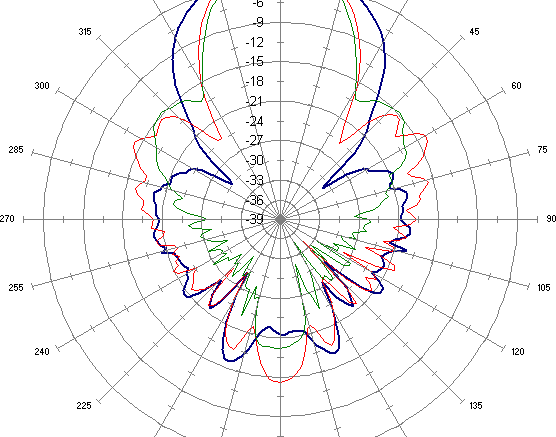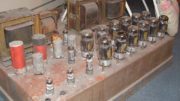I was talking to one of the customer service reps at Solid Signal and they were confused about antenna pattern charts. We both agreed that it was a good subject for a blog post.
What you see at the top of this article is an antenna reception chart. It’s also called a pattern chart, a polar plot, and a lot of other things. It’s supposed to tell you how well the antenna can perform at different angles. If you learn to read one, it will help you choose the right antenna.
The basics
The easiest way to understand this chart is to imagine you are hovering right above an antenna. The front of the antenna, which points toward the towers, is at the top. Don’t worry right now if that’s actually north, south, east, or west or even somewhere in between. What you’re doing is imagining the front of the antenna at the top.
The chart is going to tell you how sensitive that antenna is at different angles. When I say “sensitive,” I mean how well it picks up signals. Obviously you want an antenna that’s very sensitive so it picks up the most channels, but in order to get an antenna that’s sensitive in one direction, sometimes you have so sacrifice sensitivity in other directions.
For now we’re going to concentrate on the thick blue line. I’ll explain the other lines in a minute.
How to interpret the chart
The further away a line is from the center of the plot, the more sensitive the antenna is in that direction. The closer the line is to the center, the less signal the antenna is going to receive. So, let’s look at that plot again at top. The blue line is very far from center at the top, and pretty close to center in other directions. That tells you that this is a directional antenna. It picks up signal really well from the front and not super well from the sides.
You can also get an idea of the beam width. Beam width is loosely defined as how far off you can aim the antenna and still have it work. You’ll see there’s a decent area to the left and right of the top where the line is still pretty far from center. This means it’s got a decent beam width.
If you’re the sort of person who can read compass headings, in fact, you’ll agree that the beam width of the antenna in this chart is about 30 degrees. That’s the area where it’s still receiving a lot of signal.
What about the other colors?
If you’re really serious about an antenna, you’d want to have a plot like this for every single channel. The reception pattern is going to vary by frequency. Generally, you’ll get two plots at most though; one for VHF and one for UHF. Sometimes they will be two completely different things. Other times, like the plot we’re talking about, they’re distinguished by different colors. What you’re seeing here is that the blue represents UHF and the pink represents VHF-High. There’s also a green line that represents VHF-Low. (I know it’s not labeled. It would be labeled in most cases. That’s not the point.)
So what we see here is that this antenna is pretty good in both VHF-High and UHF. The beam width in the VHF-High frequencies isn’t as wide. You can see that because the pink line at the top isn’t as wide as the blue line. This antenna also does very well in VHF-Low, which is pretty rare for an antenna made these days. VHF-Low channels require a large antenna and most people just don’t tend to want that.
Still confused?
You don’t have to go it alone. If you are still having trouble understanding antenna charts or just want someone to walk you through the process, we’re here for you! Solid Signal has real technicians in our Novi, Michigan office who are trained to help you choose the right antenna. We’re here during East Coast business hours. Call us at 888-233-7563. You’ll get someone on the phone who really knows what they’re talking about. If it’s after hours, fill out the form below. We’ll get back to you, usually within one business day.





